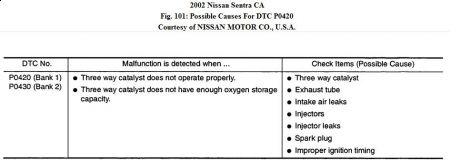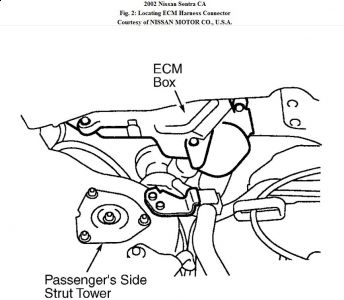Hi eckoe760,
Thank you fo the donation.
Here is a description of the problem and diagnostic procedures.
DTC P0420 OR DTC P0430
Code Description
"� DTC P0420: Catalyst System Efficiency Below Threshold - Bank 1
"� DTC P0430: Catalyst System Efficiency Below Threshold - Bank 2
NOTE:
Before performing diagnostic procedure, follow testing procedure.
Description
The ECM monitors the switching frequency ratio of HO2S1 and HO2S2. A 3-way catalyst with high oxygen storage capacity will indicate a low switching frequency of HO2S2. As oxygen storage capacity decreases, HO2S2 switching frequency will increase. When the frequency ratio of HO2S1 and HO2S2 approaches a specified limit value, the 3-way catalyst malfunction is diagnosed.
Possible Causes
For possible causes, see Fig. 101

DTC Confirmation Test
NOTE: If DTC confirmation test has been previously performed, turn ignition off and wait at least 10 seconds before performing next DTC confirmation test.
NOTE:
Open hood before conducting the following procedure. DO NOT keep engine at specified speeds longer than the specified minutes.
NOTE:
Use the following test to check overall function of 3-way catalyst. During this test, 1st trip DTC may not be confirmed.
CAUTION : DO NOT use ECM ground terminals when measuring voltage.
With Generic Scan Tool
1. Start engine and drive vehicle at a speed of more than 43 MPH for 2 consecutive minutes. Stop vehicle and leave engine running.
2. Measure voltage between ground and HO2S1 signal circuit at ECM terminal No. 62 (bank 1) or No. 63 (bank 2) by backprobing. See Fig. 2 and Fig. 3.


3. Also, measure voltage between ground and HO2S2 signal circuit at ECM terminal No. 94 (bank 1) or No. 95 (bank 2) by backprobing.
4. Increase engine speed to 2000 RPM. If switching frequency of HO2S2 is less than 75 percent of HO2S1 switching frequency, system is okay at this time.
5. If switching frequency of HO2S2 is not less than 75 percent of HO2S1 switching frequency, go to
DIAGNOSTIC PROCEDURE.
6. If HO2S1 does not switch more than 5 times within 10 seconds, diagnose and repair HO2S1. See
DTC P0133 OR P0153.
Diagnostic Procedure
1. Check Exhaust System
Visually check exhaust pipes and muffler for dent. If problem is found, repair as necessary. Perform
DTC CONFIRMATION TEST to verify repair. If problem is not found, go to next step.
2. Check Exhaust Air Leak
Start engine. Listen for exhaust air leak before 3-way catalyst. If problem is found, repair as necessary. Perform DTC CONFIRMATION TEST to verify repair. If problem is not found, go to next step.
3. Check Intake Air Leak
Listen for exhaust intake air leak after mass airflow sensor. If problem is found, repair as necessary. Perform DTC CONFIRMATION TEST to verify repair. If problem is not found, go to next step.
4. Check Ignition Timing
Check ignition timing. If ignition timing is incorrect, adjust as necessary. Perform DTC CONFIRMATION TEST to verify repair. If ignition timing is okay, go to next step.
CAUTION:DO NOT use ECM ground terminals when measuring voltage.
5. Check Injector Circuits
Turn ignition off then on. Measure voltage between ground and ECM terminals No. 101 (Red/Black wire), No. 103 (Yellow/Black wire), No. 105 (Green/Black wire) and No. 107 (Blue/Black wire) by backprobing. See Fig. 3. If battery voltage exists, go to next step. If battery voltage does not exist, repair appropriate injector or circuit as necessary. Perform DTC CONFIRMATION TEST to verify repair.
6. Check Ignition Spark
Check for spark at misfiring cylinder(s). If spark is detected, go to next step. If no spark is detected, repair ignition system as necessary. See DTC P0350: IGNITION SIGNAL (PRIMARY) NOT RECEIVED. Perform DTC CONFIRMATION TEST to verify repair.
NOTE:
After fuel injectors are removed, NEW "O" rings must be used on all fuel injectors before installation.
7. Check Injectors
Turn ignition off and allow engine to cool. Ensure no fire hazards exist and remove fuel injector assembly with fuel lines and harness connectors connected. Place a suitable cup under each fuel injector to collect fuel. Disconnect all ignition coil harness connectors. Turn ignition on. Verify fuel is not dripping from fuel injectors. If any injector is dripping,
replace fuel injectors which are leaking. Perform DTC CONFIRMATION TEST to verify repair. If no fuel injectors are leaking, go to next step.
8. Check For Intermittent
Check for intermittent condition. Perform DTC CONFIRMATION TEST to verify repair.
P0430 is for bank 2 meaning it is the one after the catalytic converter.
Bank 1 is on the exhaust manifold.
Friday, February 12th, 2010 AT 8:15 PM





